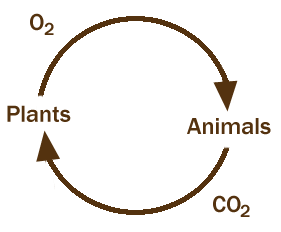The carbon oxygen cycle is a part of the larger carbon cycle on earth. Behind the phrase carbon oxygen cycle is the idea that organisms produce carbon dioxide when they combine oxygen (O2) and food to create energy. A waste product is carbon dioxide (CO2) which is released into the atmosphere. Plants can use the CO2, along with sunlight, to produce food. They also give off O2 as part of the process.
Humans breathe in air containing about 21% oxygen and a bit of carbon dioxide. They breathe out air containing about 16-17% oxygen and 4-5% carbon dioxide. Plants use energy from sunlight to convert the carbon dioxide into food or materials to grow. They give off oxygen gas. The cycle continues when animals eat the plants.
| Plants use CO2 and energy from sunlight to grow. The carbon (C) atom is taken from the CO2 and stays in the plant. |  Simple Diagram of Oxygen Carbon Cycle |
Animals use O2 and food (often plants or animals that eat plants) for energy and growth. |
The term carbon oxygen cycle is meant to highlight how plants and animals interact with carbon dioxide and oxygen. You can clearly see this taking place in a closed bottle ecosystem.
So which is right? Carbon Oxygen Cycle or just Carbon Cycle?
It all depends what you are talking about. It you only want to discuss plants and animals, Carbon Oxygen Cycle is fine to use. But if you are referring to how carbon moves around on earth you should say Carbon Cycle.
 Chalk formations off the Isle of Wight Source: Wikimedia Commons |
Carbon is cycled around in the earth many other ways than just plants and animals. For example:
- Oceans absorb a large amount of carbon dioxide. Some is used by sea creatures to make shells. When they die, the shells can fall to the bottom and eventually make sedimentary rock. That’s where chalk comes from. The carbon dioxide also makes the ocean acidic, something scientists are concerned about with rising levels of carbon dioxide in the atmosphere.
- Plants and animals are made mostly of carbon (not counting water). When they die, decomposing organisms in the soil consume them, producing carbon dioxide.
- Carbon dioxide is produced by burning fossil fuels like oil or coal (which were once plants and animals). This can be used by plants, though the present rate of fossil fuel use is producing more than the all the plants in the world can use.






